Introduction To Identifiers In Python
This blog is all about discovering new skills in python and identifiers in python. As a result, this site is dedicated to all individuals who are interested in learning to programme, whether they are students, employees, mechanical engineers, or newcomers. Python is now the most extensively used programming language by tech titans such as Google, Netflix, and Facebook. So, if this sounds fascinating, let’s get started.
We’ll learn about identifiers in Python. They are the fundamental building blocks of Python, and we utilize them in every application we write. As a result, it’s critical to know everything there is to know about them.
We’ll go through the rules for defining identifiers in python as well as all of the recommended practices for defining identifiers in python.
What is Python?
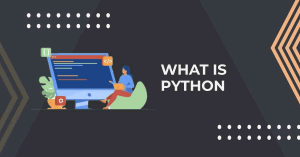
Python is a popular high-level programming language for general-purpose applications. Guido van Rossum established it in 1991, and the Python Software Foundation continues to develop it. Its syntax was created with code readability in mind, allowing programmers to communicate their ideas in fewer lines of code.
Python is a programming language that allows you to operate more quickly and efficiently with systems. Python is a scripting language that is high-level, interpreted, interactive, and object-oriented. Python is intended to be a very understandable language. It typically uses English terms instead of punctuation, and it has fewer syntactic structures than other languages. Python enables object-oriented programming, which introduces the notions of classes and objects. It allows for an inheritance, polymorphism, and encapsulation, among other things. The object-oriented method aids programmers in writing reusable code and developing applications with fewer codes.
Python is a must-have skill for students and working professionals who want to become exceptional software engineers, especially if they work in the Web Development field. I’ll go over some of the primary benefits of learning Python:
- Python is Interpreted Python is handled by the interpreter during runtime. Before running your software, you do not need to assemble it. This is similar to the programming languages Perl and PHP.
- Python is interactive in the sense that you can sit at a Python prompt and write your programmes by interacting directly with the interpreter.
- Python is Object-Oriented Python supports the Object-Oriented programming style or approach, which encapsulates code inside objects.
- Python is a Fantastic Language for Beginners Python is a great language for beginners because it allows you to create a wide range of programmes, from simple text processing to web browsers and games.
Also Read: 15 Python Libraries to be a Python Expert
Syntax
Curly braces and semicolons are not used in the Python programming language. It is a language that is similar to English. Python, on the other hand, uses indentation to define a code block. Indentation is just the act of inserting whitespace before a statement when it is required. For example:-
def func():
statement 1
statement 2
…………………
…………………
statement N
The statements in the previous example that are on the same level as the right belong to the function. In general, we can specify spacing with four whitespaces.
Characteristics In Python
The following are some of the most important features of Python programming:
- It supports OOP as well as functional and structured programming methodologies.
- It can be used as a scripting language or compiled into byte-code for large-scale application development.
- It allows dynamic type verification and provides very high-level dynamic data types.
- It allows for waste pickup to be automated.
- C, C++, COM, ActiveX, CORBA, and Java are all simply integrated.
Identifiers In Python
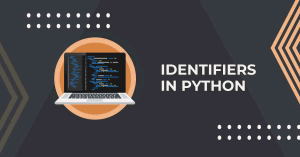
Let’s start with identifiers in python definition:
An identifier is a user-defined term that represents the fundamental building pieces of Python. A variable, a function, a class, a module, or any other object can be used. An identifier is a user-defined term that represents the fundamental building pieces of Python. A variable, a function, a class, a module, or any other object can be used. The name we provide to a variable, function, class, module, or other objects in Python is called an identifier. That is, if we wish to give something a name, we call it an identifier.
Valid Identifiers In Python Examples:
- Lowercase letters (a to z)
- Uppercase letters (A to Z)
- Digits (0 to 9)
- Underscore (_)
Invalid Identifiers In Python Examples:
- !var1
- 1 var
- 1_var
- var#1
A keyword can’t be used to identify something. Keywords in Python are reserved names that are built-in to the language. We can’t use them as identifying names since they have a special significance. If you want to see a list of all the keywords, type “help()” and then “keywords” in your Python shell to get a list of all Python keywords. The IDs can be as long as you want them to be. Of course, it cannot exceed the available memory; nonetheless, the PEP-8 standards guideline specifies that a line should not contain more than 79 characters.
We also can’t use special characters in the name of the identifiers in python. (!, @, #, $, %, etc.) are all invalid symbols. A digit cannot be the first character in an identifier. A syntax error will occur if we build an identifier that begins with a digit.
You now understand what identifiers are. So, how do we put them to use? We can’t just name identifiers whatever we like; there are specific guidelines we must follow while designating them. Python uses a combination of lowercase and uppercase letters, numerals, and an underscore to create its identification.
These are the valid characters:
- Lowercase letters (a to z)
- Uppercase letters (A to Z)
- Digits (0 to 9)
- Underscore (_)
Examples of valid identifiers in python:
- num1
- FLAG
- get_user_name
- userDetails
- _1234
Rules for Writing Identifiers In python
When it comes to writing Identifiers in python, there are a few guidelines to follow. But first, you should be aware that
Python is case-sensitive. In Python, this indicates that Name and name are two separate identifiers in python. Here are some guidelines for writing Identifiers in python.
- A combination of uppercase and lowercase letters, numerals, or an underscore(_) can be used as an identifier. Variable 1, variable for print, and myVariable are all valid identifiers in python.
- A digit cannot be the first character in an identifier. As a result, while variable1 is valid, variable1 is not.
- In our Identifier, we can’t utilize special symbols like!,#,@, percent,$, and so on.
- The length of the identifier is completely up to you.
Though there are some rigid requirements for defining identifiers in python, there are also other naming conventions that aren’t required but are beneficial to follow.
- The name of the class begins with an uppercase letter. The beginning of all other identifiers in python is a lowercase letter.
- When an identification begins with a single leading underscore, it is considered private.
- If the identifier has two underscores at the beginning and end, it is a language-defined special name.
- While c = 10 is legal, writing count = 10 makes it more logical and makes it easier to figure out what it does, even if you haven’t looked at your code in a while.
- An underscore can be used to separate multiple words, such as this_is_a_variable.
Here’s an example of a Python variable code:
|
myVariable=”hello world” print(myVariable) var1=1 print(var1) var2=2 print(var2) |
Reserved Classes Of Identifiers In Python
Some Python classes have specific meanings, and we employ patterns of preceding and trailing underscores to identify them.
-
Single leading underscore (_*)
In the interactive interpreter, this identifier is used to hold the result of the most recent evaluation. The __builtin__ module stores these findings. These are private variables, and “from module import *” does not import them.
-
Double underscores in the leading and trailing positions (__*__)
This syntax is only used for system-defined names. The interpreter and its implementations define them. Using this standard to define additional names is not encouraged.
-
Double underscores in front (__*)
Manipulation of class-private names: These category names are used in the context of class definitions. They’ve been rewritten to utilize a mangled form and avoid name collisions between the base and derived classes’ private variables.
Also Read: Complete Guide on Python Arrays
Python Keywords
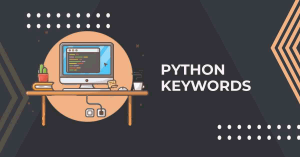
Simple terms, Python keywords are reserved words in Python. This implies you can’t use them as the names of variables, classes, or functions. So you’re probably wondering what these keywords are for. They are used to define the syntax and structures of the Python programming language. Letters (including capital and lowercase letters), numbers, and underscores can all be used in a valid identification. An identifier’s first letter should be either a letter or an underscore. Keywords like int, while, and others cannot be used as identifiers.
As of the time of authoring this tutorial, the Python programming language has 33 keywords. Although the number may fluctuate over time. In Python, keywords are also case-sensitive. As a result, they must be written exactly as they are. The following is a list of all Python programming keywords. You will be overwhelmed if you look at all of the keywords and try to figure out everything at once. So, for the time being, just remember these terms. We’ll look at how they’re used in different situations. The list of python keywords can be found in the python shell help.
Why Choose Python
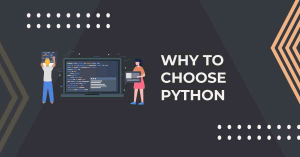
According to a domain, each programming language has a certain function or use case. Javascript, for example, is the most popular language among web developers since it allows them to manage applications using multiple frameworks such as react, vue, and angular, which are used to create attractive User Interfaces. They, too, have advantages and disadvantages. So, if we consider Python, it is general-purpose, which means it is widely used in all domains. The reason for this is that it is very simple to comprehend and scalable, which allows for rapid development. You can see why, aside from knowing python, it doesn’t require any programming knowledge, which is why it’s popular among developers.
For newcomers and beginners, the Python language is relatively simple to use and understand. Python is one of the most accessible programming languages available since it has a simple syntax and is not overly technical, allowing natural language to take center stage. Python codes can be produced and performed significantly faster than other programming languages due to their ease of understanding and use.
Also Read: Difference between Python vs Java
Python has a syntax that is comparable to that of the English language, and it allows programmers to construct programmes with fewer lines of code. Because it is open-source, there are numerous libraries available that make the job of developers easier, resulting in increased productivity. In the digital era, where information is available in enormous data sets, they may readily focus on business logic and its demanding skills.
Python has a lot of useful features for programmers. Because of these characteristics, it is the most popular and extensively used language. We’ve listed a couple of Python’s most important features below:
- Simple to use and understand
- Language That Expresses
- The language that has been translated
- Object-Oriented Programming
- Languages that are open source
- Extensible
- Learn about the Standard Library.
- Support for GUI Programming
- Integrated
- Embeddable
- Allocating Memory in a Dynamic Way
- A wide range of libraries and frameworks are available.
Python 2 vs. Python 3
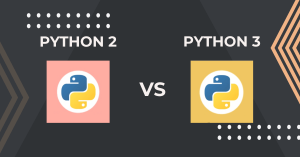
When a new version of a programming language is released, it usually supports the features and syntax of the previous version, making it easier for projects to move to the newer version. However, when it comes to Python, the two versions, Python 2 and Python 3, are significan
tly different.
The following is a list of differences between Python 2 and Python 3:
- Print is a statement in Python 2 that can be used as print “something” to print a string to the console. Print, on the other hand, is a function in Python 3 that may be used as print(“something”) to print something to the console.
- Raw input() is a function in Python 2 that accepts human input. It returns a string that represents the value entered by the user. We’ll need to utilize Python’s int() method to convert it to an integer. Python 3 on the other hand, makes use of the input() function, which interprets the type of input given by the user automatically. Using primitive operations (int(), str(), etc.), we can cast this value to any type.
- The implicit string type in Python 2 is ASCII, whereas the implicit string type in Python 3 is Unicode.
- The xrange() method from Python 2 is not available in Python 3. The xrange() function is a variation of the range() function that returns an xrange object that functions in the same way as a Java iterator. The function range() returns a list; for example, range(0,3) returns 0, 1, and 2.
- In Python 3, there is also a minor change in the way exceptions are handled. It defines a keyword as one that must be utilized. We’ll go over it in the Python programming tutorial’s exception handling section.
Guidelines For Identifiers In Python
Everyone is required to follow the name conventions. But that isn’t all! The Python community has created a few extra principles that are not mandatory but are recommended to follow for everyone’s benefit in understanding things. Let’s have a look at these guidelines.
- Class names must begin with a capital letter, whereas all other identifiers must begin with a lowercase letter.
- Use an underscore (_) to start private identifiers. It’s worth noting that this isn’t required to make the variable private. It is just for the programmer’s convenience to distinguish between private and public variables.
- Surround the names of magic methods with double underscores (__) and don’t use them anywhere else. This notation is already used by Python’s built-in magic methods. For instance, __init__ and __len__.
- Double underscores are only used in Python when dealing with mangling.
- Use names with more than one character if possible. index=1 is preferable to i=1.
- You should use underscore(_) to combine words in an identifier. Get user details, for example.
- When naming variables, use the camel case. fullName, getAddress, testModeOn, and so forth.
Conclusion
I hope you enjoyed this essay and gained an understanding of what Python is all about in a nutshell, which will provide you with some guidance as you begin your journey into the programming world and clear up any questions you may have regarding identifiers in Python. This is only the tip of the iceberg in terms of possibilities. There are many more sophisticated ideas to understand, like generators, decorators, OOP, and so on. However, in order to understand those principles, we must master the basics first.
To summarize, we learned how the fundamental building pieces, identifiers in python, are named. We went over the rules for defining identifiers in python as well as all of the basic practices that every good Python programmer adheres to. Identifiers in python, we also talked about reserved classes.
Frequently Asked Question’s
1. What are identifiers in python with an example?
Constants, variables, structures, functions, and other elements are given names called identifiers. identifiers in python is a phrase that is defined by the user and reflects the basic components of Python. Any object can be used, including a variable, a function, a class, a module, and so on. An identifier is a phrase that is defined by the user and reflects the basic components of Python. Any object can be used, including a variable, a function, a class, a module, and so on. Identifiers in python are the name that we give to a variable, function, class, module, or other objects. We call anything an identifier if we want to give it a name.
Example:
int amount;
double totalbalance;
In the example above, the terms amount and total balance are identifiers, while int, double, and int is keywords.
2. What is the difference between identifiers in python and variables in Python?
Key Differences between Identifier and Variable
- Users give a specific entity in a programme a name, which is referred to as an identifier or a variable. A variable is a name assigned to a memory region that is used to keep a value, whereas an identifier is only used to uniquely identify an item in a program at the time of execution.
- Variables are just one type of identifier; there are also function names, class names, structure names, and so on. As a result, all variables are identifiers, although the opposite is not true.
Because identifier and variable names are user-defined, it’s important to make sure that no two identifiers in python or variable names in the same program are identical. It will produce an ambiguity problem in a programme. An identifier isn’t the thing that’s being identified; it’s the thing that’s being identified. In this scenario, splitting hairs is critical.
The symbol table is usually used to keep track of them. A variable is a memory region that maintains a value that changes over time. You’re going to need the means to refer to that “thing.” The identifier is the name you give that value in your application to indicate where it is and what data type it belongs to.
3. What is data type and types of data type?
A data type is a classification of data that informs the compiler or interpreter how the programmer intends to use the information. Integer, real, character or string, and Boolean data are all supported by most computer languages. Most programming languages include common data types that perform and react in a comparable way from one language to the next. There may be other sophisticated and/or composite data kinds that vary by language.
A data type is a categorization in programming that determines the type of value a variable possesses and the types of mathematical, relational, and logical operations that can be performed on it without creating an error. A string, for example, is a data type for classifying text, while an integer is a data type for classifying entire integers.
A data type is a property that instructs a computer system on how to interpret the value of a piece of data. Understanding data types ensures that data is collected in the desired format and that each property’s value is as expected.
Please note that data types should not be confused with the two forms of data that make up customer data—entity data and event data. To effectively describe event and entity properties, you’ll need a thorough understanding of data types. To assure data accuracy and prevent data loss, a well-defined tracking plan must include the data type of each property.
4. What do you mean by identifier?
An identifier is a term that designates the identification of a single item or a single class of objects, where the “object” or “class” can be an idea, a physical countable object (or class thereof), or a physical uncountable substance (or class thereof).
In C#, an identifier is the name given to a programme element by the user. A namespace, class, function, variable, or interface can all be used.
Identifiers in python are symbols that are used to distinguish one programme element from another in the code. Types, constants, macros, and parameters are also referred to as variables. The meaning and usage of the element being referred to should be indicated by the identifier name.
5. What is the purpose of the identifier?
A Python identifier is a name for a variable, function, class, module, or other object in Python. An identifier begins with a letter from A to Z, or a to z, or an underscore (_), then zero or more letters, underscores, or numbers (0 to 9).
Within identifiers in python, punctuation characters like @, $, and percent are not allowed. Python is a programming language that is case sensitive. As a result, in Python, manpower and manpower are two separate identifiers in python.
- The name of the class begins with an uppercase letter. The beginning of all other identifiers is a lowercase letter.
- The presence of a single leading underscore in an identifier implies that it is private.
- An identification that begins with two leading underscores is considered to be very private.
- The identifier is a language-defined special name if it also ends with two trailing underscores.
6. What are valid identifiers in Python?
Letters (including capital and lowercase letters), numbers, and underscores can all be used in a valid identification. An identifier’s first letter should be either a letter or an underscore. Keywords like int, while, and others cannot be used as identifiers in python.
7. What are the rules for naming identifiers in python?
- Only alphanumeric characters (a-z, A-Z, 0-9) (i.e. letters and numerals) and the underscore(_) sign are allowed in an identification.
- The names of the identifiers in python must be unique.
- An alphabet or underscore must be the first character.
- Keywords cannot be used as identifiers.
- The first thirty-one (31) characters are the most important.
- It can’t have any white spaces in it.
- Case matters when it comes to identifiers in python.
8. What is the difference between identifiers in python and keywords in python?
Keywords and identifiers in python are significant terms in the field of programming languages. Some programming languages provide keywords and identifiers in python that the compiler understands. Keywords, in general, are predetermined and specialized reserved words with special meanings. An identifier, on the other hand, is a separate term or name assigned to a variable, class label, or function in a programme or function. Let’s look at how keywords and identifiers in python are different.
- keyword:-
Keywords are terms that have been pre-defined and assigned a certain meaning. Keywords aid in the definition of any programme statement. There are 32 keywords in the C programming language. Double, int, auto, char, break, and other keywords are instances of keywords.
- Identifier:-
An identifier is a name created by the programmer to identify a variable, structure, class, or function. It’s critical to give the identifiers in python some intelligible names so that the code can be read fast.
9. Can identifiers in python be used as a variable name?
In Java, identifiers in python are symbolic names that are used to identify objects. They can be anything from a class name to a variable name to a method name to a package name to a constant name. There are, however, several reserved words in Java that cannot be used as identifiers. Before declaring any identifiers in python, there are various standards that should be followed. Let’s look at it with the help of a simple Java program:
public class HelloJava {
public static void main(String[] args) {
System.out.println(“Hello DataTrained”);
}
}
Variables are just one type of identifier; there are also function names, class names, structure names, and so on. As a result, all variables are identifiers in python, although the opposite is not true. Variable names are used in Java (and many other programming languages) to refer to the names of the boxes. Because we can change the value inside the box, the word “variable” signifies “changing.” However, we are unable to modify its name. Variable names belong to the category of identifiers in python.
10. What is an address name identifier?
A number between 0 and the number of addresses on the line minus one is an address identifier. An address identifier is a unique number allocated to a device that does not change even when the operating system is upgraded. The combination of device identifier and address identifiers in python uniquely identifies a specific address.














2 responses to “Identifiers in Python | 5 Best Practices | DataTrained”
[…] What is a Mutable Object In Python? […]
[…] Also Read: What are Identifiers in Python? […]